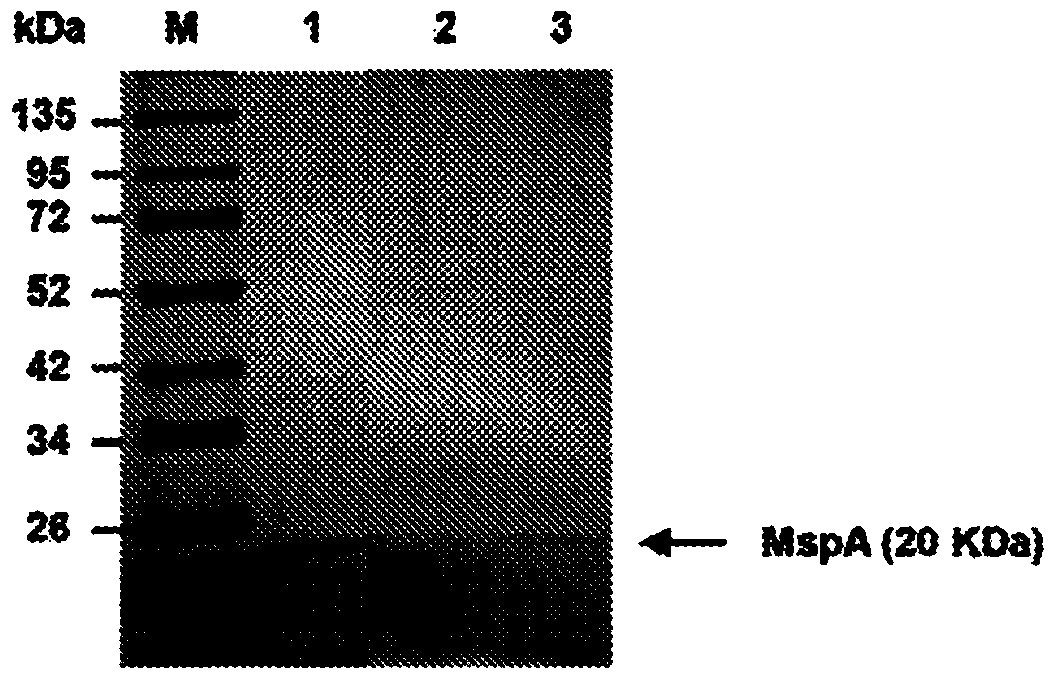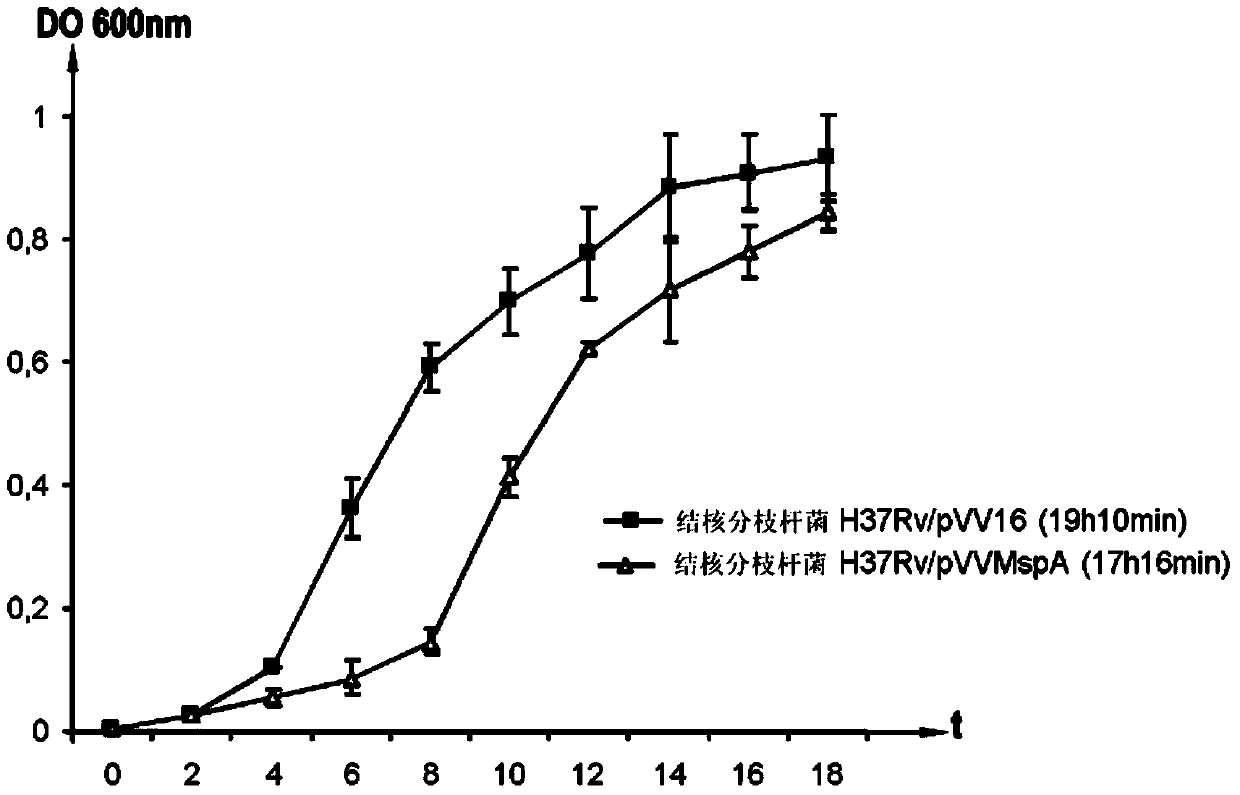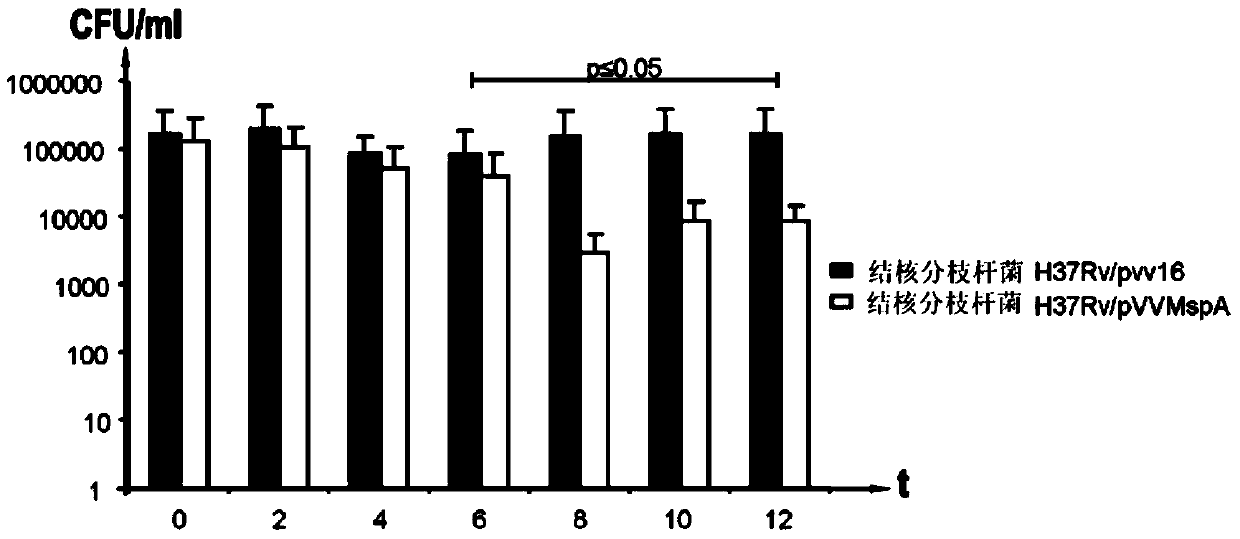Method for attenuating a bacterium of the mycobacterium tuberculosis complex for producing a tuberculosis vaccine
A technology of mycobacterium tuberculosis and mycobacteria, applied in the direction of microorganism-based methods, methods using microorganisms, biochemical equipment and methods, etc., can solve the problems of weakening growth and not effectively adding genes
- Summary
- Abstract
- Description
- Claims
- Application Information
AI Technical Summary
Problems solved by technology
Method used
Image
Examples
Embodiment 1
[0046] Example 1. Growth of Mycobacterium tuberculosis expressing MspA in sterile media
[0047] First, the inventors amplified the gene encoding the MspA porin from the Mycobacterium smegmatis genome, and then inserted the amplified product into the expression vector pVV16 [16] to obtain the plasmid pVVMspA. Two genes for proteins of kanamycin and kanamycin (selection markers). The inventors then incorporated the pVVMspA plasmid into the M. tuberculosis strain HS7Rv by electroporation, and screened transformed clones using hygromycin and kanamycin as antibiotics.
[0048] Experimental protocol
[0049] 1) Construction of pVVMspA plasmid:
[0050] First, the inventors extracted genomic DNA from M. smegmatis strain mc155 (ATCC 700084) and used standard PCR to amplify the gene encoding the MspA porin [5].
[0051] The sequence gi_118467340 of the gene is the following sequence SEQ.ID.N°1:
[0052] 5′-
[0053] ATGAAGGCAATCAGTCGGGTGCTGATCGCGATGGTTGCAGCCATCGCGGCGCTTTTCACGAGCA...
Embodiment 2
[0069] Example 2. Growth of co-cultures of Mycobacterium tuberculosis expressing MspA and the amoebae Acanthamoeba polyphaga
[0070] 1) Experimental procedures:
[0071] 10mL amoeba suspension (~10 5 Amoeba / mL) inoculation~10 6 Mycobacteria / ml (MOI=10). As a control, Acanthamoeba polyphagoides and mycobacteria were cultured separately in PAS buffer (Page's modified Neff's amoeba saline) (21, 22, 23). After an incubation period of 24 h at 32°C, the co-cultures were washed three times with PAS and incubated in 10 ml PAS for 10 to 15 minutes at 32°C.
[0072] 2) Results:
[0073] Using amoebae as eukaryotic cells, two strains of Mycobacterium tuberculosis H37Rv / pVV16 and Mycobacterium tuberculosis H37Rv / pVVMspA were observed to survive in the experiment after 8 days of co-culture, but the strains of Mycobacterium tuberculosis H37Rv / pVVMspA expressing the MspA porin The number of mycobacteria was significantly reduced (P≤0.05; Student's statistical test). On day 12, the num...
Embodiment 3
[0076] Example 3. Growth of co-cultures of M. tuberculosis expressing MspA and human macrophages (hMdM) or mouse macrophages (BMDM):
[0077] 1) Experimental procedures:
[0078] Using Ficoll gradients (MSL, Eurobio, Courtaboeuf France) from buffy coat (leukopack) (France, Marseille, National Blood Service (Etablissement du Sang)) to isolate BMDM[24] and hMdM, which were then differentiated, and respectively (10 5 cells / well) were seeded in 24-well culture plates in RPMI 1640 medium containing 10% FCS. BMDM and hMdM were infected with Mycobacterium tuberculosis, Mycobacterium tuberculosis H37Rv / pVV16, and Mycobacterium tuberculosis H37Rv / pVVMspA for 24 hours, respectively. Serum (FCS) was incubated in RPMI1640 medium for different periods of time. As a control, each cell type and mycobacteria were cultured separately.
[0079] Determine the number of intracellular mycobacteria (CFU):
[0080] At the given times, infected cells were lysed with 0.1% sodium dodecyl sulfat...
PUM
 Login to View More
Login to View More Abstract
Description
Claims
Application Information
 Login to View More
Login to View More - R&D
- Intellectual Property
- Life Sciences
- Materials
- Tech Scout
- Unparalleled Data Quality
- Higher Quality Content
- 60% Fewer Hallucinations
Browse by: Latest US Patents, China's latest patents, Technical Efficacy Thesaurus, Application Domain, Technology Topic, Popular Technical Reports.
© 2025 PatSnap. All rights reserved.Legal|Privacy policy|Modern Slavery Act Transparency Statement|Sitemap|About US| Contact US: help@patsnap.com



